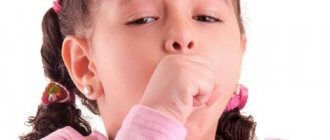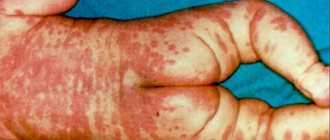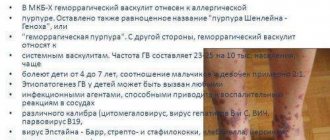Causes of salmonellosis. Main routes of infection
- Food is the most common route of infection, the cause of which is insufficient heat treatment, violation of sanitary and epidemiological standards for storage and transportation of products, and failure to comply with personal hygiene rules.
- Contact and household. Children become infected with salmonellosis through contact with a sick person or with people caring for animals that are infected or are carriers of the infection. Bacteria can persist for a long time on toys, clothing, towels and other items that a sick person has come into contact with. This route of infection is the main one for infants.
- Transplacental - from mother to fetus.
You can become infected with salmonellosis even where you did not expect it at all: for example, by eating a cream cake in a cafe where there is poor sanitary control over the production and quality of products. In some products (milk, meat products), salmonella can not only survive, but also multiply. Salting and smoking have a very weak effect on them, and freezing even increases the survival time of microorganisms in products. Almost all animals are infected with salmonella to one degree or another, many of them are healthy carriers. Among birds, chicken is the leader in the likelihood that an absolutely healthy bird is a carrier of salmonellosis. Today this is one of the leading ways of spreading this disease.
The unique ability of the bacterium is that when food is contaminated, it does not in any way change its color, smell or taste. Any product where salmonella can potentially multiply is a danger to the child.
Photo source: shutterstock.com
No one is immune from salmonellosis infection. There are two ways to avoid illness: not eating foods or processing them thermally.
The child’s body is very vulnerable to various infectious diseases under the influence of negative factors. After all, in childhood, intestinal immunity only develops and still weakly protects the baby. Therefore, to prevent the disease, doctors do not recommend that children under 5 years of age have contact with pets and eat raw animal products.
Treatment methods for salmonellosis
Children with severe gastroenteritis and generalized forms are hospitalized in a hospital. For the first 2–3 days they are prescribed strict bed rest.
The first stage of treatment is gastric lavage . It is carried out no later than three hours from the moment of ingestion of contaminated food. A cleansing enema also has a positive effect. The child is given enterosorbents, which absorb toxins and remove them from the body. Then rehydration therapy is carried out, aimed at restoring the water-salt balance of the body. Antibacterial therapy is indicated only in severe cases. Further drug treatment is aimed at restoring intestinal function and its microflora. For this purpose, probiotics are used, which contain lactic acid bacteria. They colonize the digestive tract and normalize its function.
Symptoms of childhood salmonellosis:
- acute onset;
- rumbling in the stomach;
- severe pain in the navel area;
- nausea;
- vomiting, sometimes with the presence of mucus and bile;
- diarrhea;
- a sharp increase in temperature;
- lethargy, weakness;
- the tongue is covered with a characteristic coating, and an unpleasant odor comes from the mouth.
Children under two years of age are most susceptible to infection, since they put dirty hands and various objects in their mouths when teething, and hygiene skills at this age are still poorly developed.
Diagnosis of childhood salmonellosis
After clarifying complaints and conducting an examination, laboratory diagnostics are carried out to identify the pathogen:
- General blood analysis . With salmonellosis, the number of neutrophils increases, they acquire toxic granularity, and the erythrocyte sedimentation rate (ESR) increases.
- General urine analysis . Makes it possible to identify kidney damage and the presence of a purulent focus in them.
- Bacteriological examination is the most important element of diagnosis. For this purpose, samples of stool, urine, vomit or gastric lavage are taken. Then the material is sown on nutrient media. The doctor receives the results of the study in 2–4 days, identifying salmonella by the growth pattern of the colonies.
- Using scatological analysis, the localization of the inflammatory process is assessed. In patients with gastroenteritis, fatty acids and undigested meat and plant fibers are detected in the stool. With colitis, a large amount of mucus, leukocytes and red blood cells is observed.
- Serological diagnostics is aimed at identifying antibodies to Salmonella. To do this, use the indirect hemagglutination reaction (IRHA) or the immunofluorescence reaction (RIF).
- A quick and accurate diagnostic method is polymerase chain reaction (PCR) . It is used to determine the proteins of the pathogen.
Symptoms of salmonellosis in children under one year of age:
- lethargy, loud and sharp sounds cause anxiety in the baby;
- refusal to eat;
- frequent bowel movements;
- on the 3rd day of illness the temperature rises;
- the stool becomes liquid, watery, and green in color;
- A dry mouth and extreme thirst are a symptom of the onset of dehydration.
Salmonellosis in children under one year of age can last several weeks or even months. After the illness, the baby may have abdominal pain, irregular bowel movements, and increased allergies for 2 months.
Salmonellosis in children 2 years of age and older occurs in the form of gastritis and gastroenteritis.
Types of salmonellosis
Depending on the location of the pathogen and the severity of the disease, different types of salmonellosis are distinguished.
Gastrointestinal salmonellosis
Gastrointestinal salmonellosis occurs as a result of the pathogen entering the gastrointestinal tract. Depending on the distribution, the following forms are distinguished:
- Gastritis. Develops in children under 3 years of age. Its symptoms resemble food poisoning. It begins acutely, accompanied by general malaise, vomiting, and loss of appetite. There is pain in the epigastric region. Only the stomach is affected, the intestines are not involved.
- Gastroenteric. It occurs in older children and is characterized by severe symptoms of intoxication, vomiting, loose, profuse bowel movements mixed with mucus and an unpleasant odor. A few hours after the onset of the disease, widespread pain is observed throughout the abdomen, rumbling and splashing noise in the stomach.
- Gastroenterocolitic. Typical for children of the first year of life. It begins acutely, the temperature rises to 37–38°C and lasts 6–7 days. Diarrhea and vomiting are particularly pronounced. The frequency of bowel movements reaches 12–15 times a day. Blood streaks and mucus may be found in the stool. There is bloating of the abdomen, it becomes painful when touched, the liver and spleen are enlarged.
- Colitic. Symptoms of damage to the large intestine are noteworthy: tenesmus (false painful urge to go to the toilet), cramping abdominal pain, scanty bowel movements (like “rectal spitting”).
Generalized salmonellosis
Generalized salmonellosis occurs when bacteria enter the bloodstream. The following forms are distinguished:
- Septic. Occurs in half of young children (under 3 years). It begins with chills, febrile fever, and symptoms of gastroenteritis. After 2 days, the latter disappear, but fever and general malaise persist. The child complains of weakness and poor sleep. Characteristic symptoms include the appearance of a herpetic rash on the lips, redness of the face, and a decrease in blood pressure and pulse.
- Typhoid-like. This form is specific in its wavy flow, which resembles the picture of typhoid fever. On the 6th–7th day from the onset of the disease, a roseola rash appears on the abdomen. Patients are apathetic, lethargic, the face becomes pale. As a result of exposure to toxins, the functioning of the heart and lungs is disrupted. The remaining symptoms are similar to the septic form. The typhus-like variant of salmonellosis is associated with the appearance of purulent foci in the internal organs, which periodically spread the infection throughout the body.
Treatment of salmonellosis in children
The first signs of salmonellosis are a reason for the mother to call an ambulance. Treatment of childhood salmonellosis involves preventing parents from becoming dehydrated. Any child's first aid kit should always include oral rehydration products. It is important to give the child a sufficient amount of liquid - this can be water, compote, or fruit juice.
Photo source: shutterstock.com
Key points during treatment:
- oral rehydration with prepared saline solutions;
- actively feeding the child: if the child refuses to drink, it is necessary to feed him with a teaspoon or from a syringe every 5 minutes;
- the first day - fasting, then - a special diet;
- preparations containing probiotics;
- antipyretics at high temperatures;
- Bed rest is indicated for mild cases of the disease for 1 week, for severe cases - up to 3 weeks.
The basis for hospitalization is the severity of the child’s condition. In mild cases of the disease, salmonellosis is treated at home. With strict control over the amount of fluid you drink and following a diet, the disease usually goes away on its own.
Quite often, mothers and fathers mistake the symptoms of salmonellosis in 6-year-old children for banal poisoning. Therefore, it makes sense to get tested for salmonellosis even when treating at home. This will allow you to accurately find the cause of the disease and make the correct diagnosis.
It has been scientifically proven that taking antibiotics for salmonellosis prolongs the course of the disease. Today, there are international recommendations for the use of antibiotics in the treatment of salmonellosis. They are needed for children with weakened immune systems, children under 2 months of age and when salmonella penetrates beyond the intestines.
40% of all salmonella are multidrug-resistant bacteria, which means they are practically unaffected by antibiotics. Scientists around the world urge not to treat salmonellosis with only intestinal manifestations with antibiotics. Nevertheless, our country’s protocol provides for treatment of children of any age and with any severity of the disease with antibiotics for salmonellosis.
Symptoms of salmonellosis
Symptoms of the disease largely depend on the age of the patient and the type of disease. In newborns of the first week, the disease begins abruptly. First there is a decrease in appetite, the baby refuses to feed. The skin turns pale, the child becomes apathetic. Digestive disorders, mainly diarrhea, are characteristic. The stool is watery, with green lumps and mucus. At this age, there is no fever or vomiting, and the spleen and liver are noticeably enlarged. Manifestations of exicosis (dehydration) and flatulence rapidly increase. There is a high risk of hemocolitis - bleeding in the colon.
In children of the first year of life (over 10 days), salmonellosis has a sudden onset with fever up to 37–39°C. Severe vomiting and regurgitation during eating are observed. The stools are liquid, greenish, sometimes streaked with blood. As a result of dehydration, cramps appear, the skin becomes dry and pale.
A child under 3 years of age has a high risk of developing purulent lesions in various organs. Therefore, in addition to the above symptoms of salmonellosis, the patient may have signs of pyelonephritis, meningitis, cystitis, etc.
The clinical picture in older children is similar to the course of salmonellosis in adults. In the first hours of the disease, there is a slight malaise, which is accompanied by bloating. Then the temperature rises sharply, dizziness, pain in the temples, and aches appear. Signs of intoxication reach their maximum on the second day. At the same time, signs of gastroenteritis appear: abdominal pain, vomiting, which contains food debris. Further, the vomit becomes greenish and watery. Later diarrhea follows. Dehydration of the body quickly increases.
After gastroenteritis, a child may develop a septic form of salmonellosis, which is characterized by an increase in fever, depression of the nervous system and hemodynamic disturbances.









